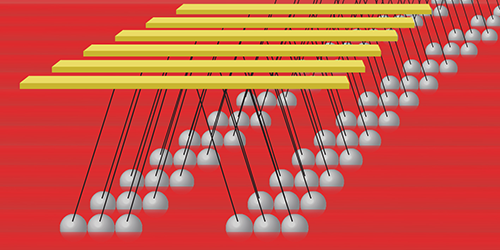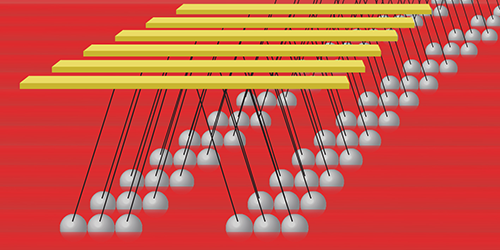Pathway to Quantum Thermalization
The role of chaotic motion in the thermal equilibration of classical systems is well understood—there is little mystery in how cold milk and hot coffee warm and cool to reach the same temperature. But the same is not true for thermalizing quantum systems, where chaos’s function is unexplained. Now, in experiments and simulations, Benjamin Lev, from Stanford University, California, and colleagues show how the onset of chaotic motion drives interacting quantum particles to thermal equilibrium. This insight may help in the design of technological devices that rely on nonequilibrium quantum effects.
To explore the problem, the team turned to a quantum Newton’s cradle. This apparatus is modeled on the desk toy that consists of a line of suspended metal balls that can be set to swing in different periodic patterns. In a quantum Newton’s cradle, atoms replace the balls, and lasers confine the atoms in a row. Additional lasers kick the atoms into motion, causing them to oscillate back and forth as in the toy. However, unlike the toy, the atoms can both collide and pass through one another because of the oddities of quantum physics.
The team built 700 individual magnetic quantum Newton’s cradles using dysprosium atoms. Because dysprosium is highly magnetic, the atoms in each cradle interacted with one another via magnetic forces. The team tuned the strength of these interactions by changing the orientation of each atom’s magnetic dipole via an applied magnetic field. As the strength of the interaction increased, the team observed that the motion of each cradle’s atoms transitioned from periodic to chaotic. Then the momentum distribution of the atoms rapidly approached a thermal distribution, indicating the system was equilibrating. These results provide critical data for researchers pursuing a general theory of quantum thermalization.
This research is published in Physical Review X.
–Christopher Crockett
Christopher Crockett is a freelance writer based in Montgomery, Alabama.





